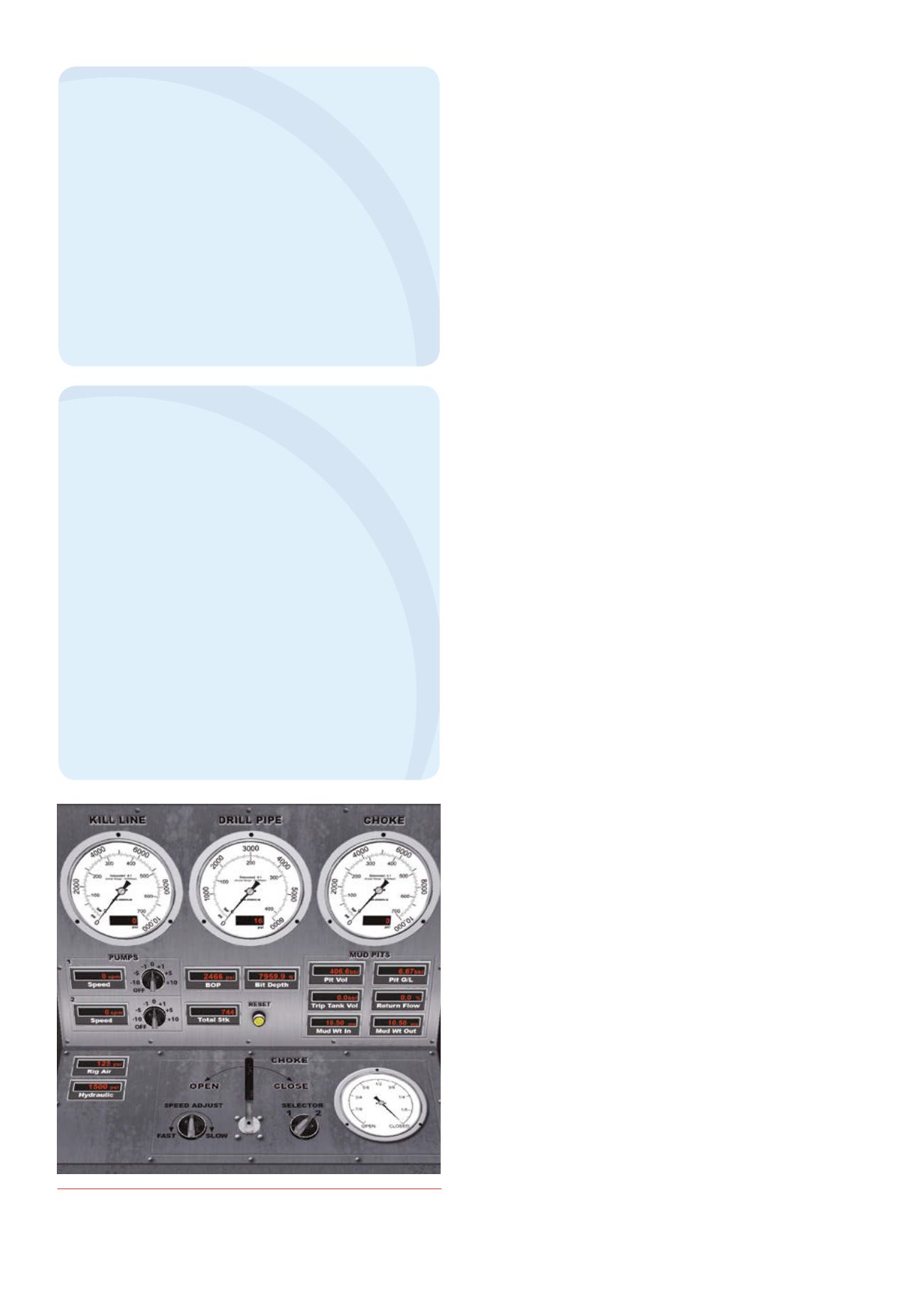
56 |
Oilfield Technology
December
2014
International Association of Oil and Gas Producers 476 (see
sidebar) is improving the way the oil and gas industry addresses well
control training, and more drilling contractors have stepped up their
efforts by adopting competency‑assurance training to maintain their
crews’ skills during the two‑year timespan between well control
recertification.
Takethetrainingtothecrews–not thecrews tothe
training
Check‑6 has developed a portable competency‑maintenance
training system for well control that uses fighter pilot‑inspired
computer simulation and a virtual instructor: The Well Control
Competency Assurance Training System. The system eliminates
the expense of live instruction, enabling contractors and operators
to continuously maintain all their employees’ well control skills
during their regular tours – on the rig itself.
North Atlantic Drilling, the first to adopt the new system
over a year ago, has deployed the portable training system on
all eight of its rigs. This allows its crews to maintain their well
control competency through regular training vignettes during their
offshore hitches.
“We want our candidates to take their lessons during their
normal working hours offshore,” said Per Svanes, Drilling Manager
for North Atlantic Drilling. Every quarter, employees review well
control through highly realistic computer simulations. Each of the
eight lessons contains six to 10 well control scenarios that can be
addressed one at a time or all at once. An entire lesson takes each
crewmember an average of 1 ½ hours to complete. There are over
120 training vignettes that include both primary and secondary
well control scenarios.
It is important to remember that a kick does not come with a
four‑day training course in front of it. The tool is designed to train
individual knowledge, skills and understanding of well control
– regularly instead of every second year. The system has its own
independent learning management system; meaning it would not
need to connect to a company’s existing training system.
Per Svanes states that, after more than a year’s experience with
the system, the positive feedback from his users continues. “The
lessons are challenging and offer effective individual learning,”
he said.
It is worth remembering Chesley Sullenberger, the pilot who
landed his plane on the Hudson River. He had never done it
before, but he had probably practiced similar emergency landings
in a simulator. The simulator helps create close‑to‑real‑life well
control experiences. The goal is to raise levels of competence and
confidence in managing a real world situation.
After evaluating the system at North Atlantic Drilling, parent
company Seadrill has budgeted to install the Well Control
Competency Assurance Training Systems on all 64 of its rigs
worldwide.
Systemanalysis
The Well Control Competency Assurance Training System
consists of 126 training sessions that assess and document each
crewmember’s readiness and competency in kick detection and
shut‑in, as well as managing secondary well control after shut‑in.
It includes:
Ì
Simulation of both primary and secondary well control
scenarios that support individual learning objectives.
Ì
Well control crew testing and skill evaluation using
scenario‑based training with built‑in instruction and
remediation.
IOGP 476: Recommendations for
enhancement to well control training,
examination and certification
After Macondo, the International Association of
Oil and Gas Producers (IOGP) prepared new global
recommendations for well-control training. In short,
its conclusion recommends training become more
role-specific and progressive.
Furthermore, it recommends five levels of both rotary
drilling well control and well intervention pressure-control
training, using updated curricula and accredited
examinations for critical positions.
‘We can’t afford it’
The IOGP recommendations for continuing education
have not been adopted yet, but the Well Control
Competency Assurance Training System exceeds the
requirement and sets a new standard for well control
currency and maintenance. At a cost of less than
US$ 50 000/y per site, if a rig has 50 well control users,
that is less than US$ 2.75 per student per day – small in
comparison to offsite training or onsite training by a live
instructor. Plus, the system is always available to crews so
that whether they are vying for promotion, or preparing
for certification, they can continuously hone their skills
like a true professional.
Check-6 maintains the computer-based curriculum
and all the training records, with no additional burden on
clients’ IT department.
Expert analysis suggests the oil and gas industry
cannot afford not to meet these higher standards – for
now. Experience should not be measured in years – but
by the number of quality experiences that prepare people
for the unexpected.
Figure 1.
Remote choke panel.


